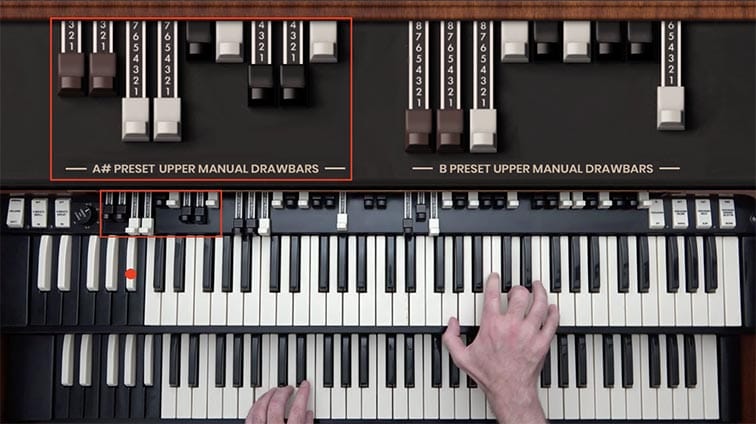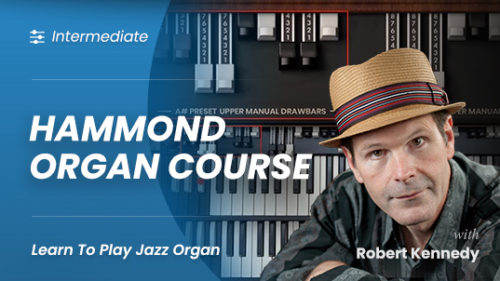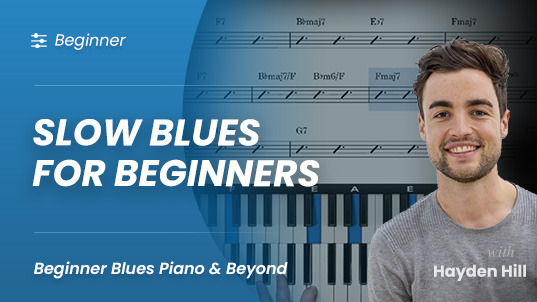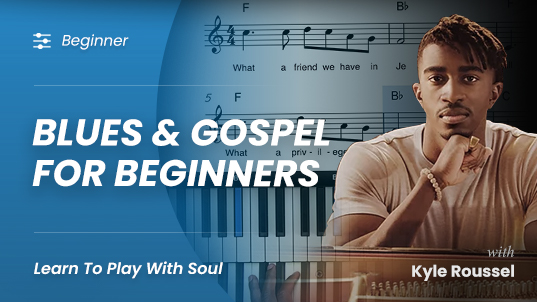Intro To Jazz Organ Course
Learn to play the F Jazz Blues using the Hammond Organ. We explore the B3’s anatomy & controls, walking bass lines, comping, turnarounds, & improvisation.
to this course, right now!
Summary Information:
One-time purchase - learn at your own pace, with unlimited access to this course.
- Difficulty: Intermediate
- View Online with Lifetime Access
- Video Slow Down Controls
- A/B Loop
- Theory Lessons
- Performances & Arrangements
- 15 PDF Files & Lesson Supplements
Intro To Jazz Organ Course
Learn to play the F Jazz Blues using the Hammond Organ. We explore the B3’s anatomy & controls, walking bass lines, comping, turnarounds, & improvisation.
Welcome to our ‘Intro To Hammond Organ’ course.
This course has been designed for students who are new to the Hammond organ and those who are interested in learning about the intricacies of this unique instrument.
Many of the theoretical concepts covered in the course are applicable to blues and jazz piano students. We explore walking bass lines, comping, improvisation, turnarounds, and finally we will apply all of these concepts to create a full performance over the 12 Bar Jazz Blues in F.
The Anatomy Of The Hammond B3 Organ
We start this course by exploring the anatomy of the Hammond B3 organ. We discuss the manuals, drawbars, presets, pedals, percussion circuit, & chorus vibrato settings.
Walking Bass On The Hammond
Walking bass is the most common type of bass that you will hear in jazz and jazz blues on the organ. For jazz organists, walking bass is played primarily with the left hand on the lower manual with some elements added and supported by the bass pedals.
Walking bass on the lower manual gives us a greater ability to articulate notes than walking with just the bass pedals.
Pedal Thumps & Bass Lines
The pedal thump is a low frequency thump that is used to accent the beginning of the notes in our bass line. When playing the bass pedals on Hammond organ, we generally alternate between playing pitch-less pedal thumps with following the melodic contour of the bass line that we are walking on the lower manual.
Hammond Drawbar Settings For Comping
Most Hammond organ comping uses the lower manual with the same drawbar setting that we used for our left hand bass lines. We’re lucky that the same setting is great for comping and for bass lines as we can walk bass and comp on the same drawbar preset.
Useful Drawbar Registrations
We start with some useful drawbar registrations that are commonly used in jazz organ for right hand soloing and improvisation.
- Jimmy Smith Registration — full version and “nasal” version
- Charles Earland Registration
- Groove Holmes Registration
- Erroll Garner Registration & Squabbling
- Full Organ Registration
The Blues Scale & Chord Tones
Robert demonstrates a framework for constructing idiomatic-sounding blues improvised phrases:
- The departure
- The middle part
- The arrival or resolution
The arrival moves out of the blues scale into a chord tone and amounts to a release of tension in the phrase.
Turnarounds For F Blues
We look at the structure of 12-bar blues and explore some of the embellishments you can use on the chord progression.
We start with a fairly basic jazz blues chord progression as the basis for our embellishments and gradually layer in more harmonically interesting chords and cadences.
In this lesson we explore the anatomy of the Hammond B3. We discuss the drawbars, presets, pedals, percussion, & chorus vibrato settings.
Walking bass is the most common type of bass that you will hear in jazz and jazz blues on the organ. In this lesson we explore the theory.
For jazz organists, walking bass is played primarily with the left hand on the lower manual, with some elements supported by the pedals.
Understanding the foldback of the pitches on the lower manual is important to inform the melodic contours of your bass line.
In this lesson we will explore right hand comping voicings and technique to accompany our own solos or a solo of someone else.
You can use these comping exercises and drills to strengthen your right hand comping on Hammond organ as well as on the traditional piano.
We will cover with some useful drawbar registrations that are commonly used in jazz organ for right-hand soloing and improvisation.
In this lesson we will learn some techniques for creating improvised solos and we will explore how we can build our melodic improvisations.
In this lesson we'll look at the structure of 12-bar blues and explore some of the embellishments we can apply to the chord progression.
We incorporate all of the theory and material covered in the prior lessons in this course and then analyse each aspect of the performance.
-
Common Drawbar Registrations File Type: pdf
-
Walking Bass Line Examples File Type: pdf
-
Lower Manual Bass & Pedals Notation & Examples File Type: pdf
-
Comping Lesson Notation File Type: pdf
-
Comping Drills & Practice Guidance File Type: pdf
-
Tremolos Notation File Type: pdf
-
Contrasting Time Riffs Notation File Type: pdf
-
Improvised Solo Transcription File Type: pdf
-
Licks & Riffs Lesson Notation File Type: pdf
-
Turnarounds & Reharmonisations File Type: pdf
-
Performance Notation: Licks & Riffs File Type: pdf
to this course, right now!






